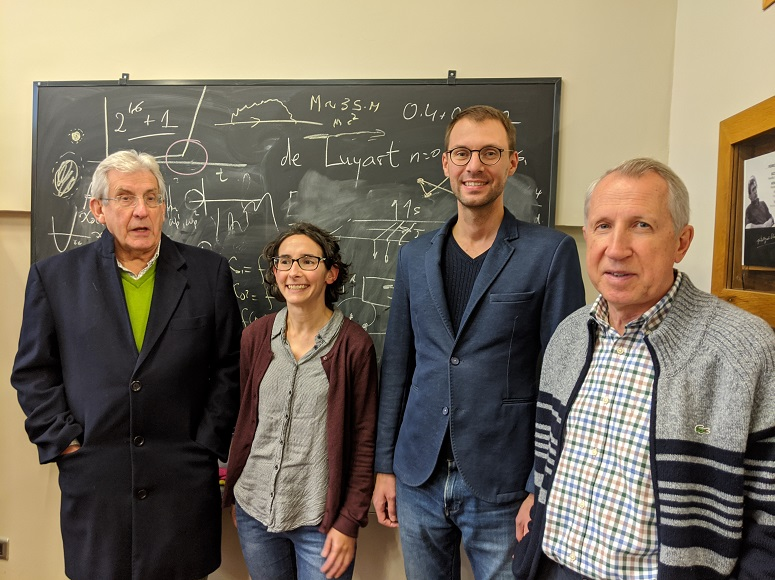Dec 20 2019
Topological insulators are materials that act as insulators in bulk, that is, they do not permit electric currents in their volume but act as conductors on the surface.
 The researchers. Image Credit: UPV/EHU
The researchers. Image Credit: UPV/EHU
Within a topological insulator, the circulating electric current does not experience any energy loss. This is different from the typical conductors—that is, metals. This characteristic paves the way for many potential applications in electronics, as it would help in producing devices that are faster, more efficient, and consume minimal energy.
Such an objective is not only preferred but also essential in today’s circumstances of the fast growth of energy demand across the world, which endangers the environment.
Because of that reason, the topological insulators that were discovered approximately 10 years ago led to an international research boom in the fields of condensed matter physics and nanotechnology.
When considering technological applications—for instance, information technologies—one of the major difficulties faced during these years of robust research has been the development of a magnetic topological insulator.
To date, magnetic topological insulators had just been developed by what is known as the extrinsic route. This extrinsic route involves doping nonmagnetic topological insulators that have magnetic atoms.
Now, due to the efforts of a research team from the University of the Basque Country (UPV/EHU), the Donostia International Physics Center (DIPC), and the Materials Physics Center (CFM, CSIC-UPV/EHU joint center), an intrinsic magnetic topological insulator can be developed—specifically, one that has magnetic characteristics by its very own nature.
The research team, including DIPC scientists Mikhail Otrokov (CFM Ikerbasque Research Fellow), Evgueni Chulkov (UPV/EHU, Euskadi Research Prize 2019), María Blanco Rey (UPV/EHU), and Pedro M. Echenique (UPV/EHU, DIPC President), has theoretically predicted the first-ever intrinsic magnetic topological insulator that has chemical formula of MnBi2Te4.
This prediction was successfully made, thanks to the extensive experience of the research team focused on the fields of material science, magnetism, and topological insulators in general.
Previous work from different approaches led us to the conclusion that the intrinsic route was the only feasible one nowadays. Then, we directed our efforts to find an intrinsic magnetic topological insulator based on our prior experience. Thanks to that, we knew what crystalline structure and atomic composition such a material should have.
Mikhail Otrokov, Research Leader and Ikerbasque Fellow, Materials Physics Center
The theoretical prediction of the first magnetic topological insulator was performed in Donostia (Basque Country, Spain). The place also served as the base camp from where the experimental confirmation of the magnetic topological insulator was coordinated. The study has involved specialists focused on different fields, from top research centers in the United States, Japan, Austria, Italy, Germany, Azerbaijan, and Russia.
The outcomes of the study will be shortly published in the prominent Nature journal.
For experimental validation, chemical synthesis experts will initially synthesize the compound crystals, informed Otrokov. After the samples are produced, they will be subjected to an array of characterization experiments such as electronic, structural, magnetic, of atomic composition, of transport, etc. until the estimated properties were seen and validated.
The outcomes of the study have been received well by the international scientific community. The study has already been publicized via an open-access server and lectures have been delivered by the study authors at international conferences.
At present, MnBi2Te4 and other types of materials based on it have been analyzed in a number of research centers, those of China and the United States demonstrating the most powerful activity.
MnBi2Te4, besides being an intrinsic magnetic topological insulator, has turned out to be antiferromagnetic, just as we had calculated.
María Blanco Rey, University of the Basque Country
Anti-ferromagnetism includes an atomic-scale magnetic order in such a way that the material does not have any net magnetization. Consequently, materials like these are relatively more powerful against magnetic perturbations.
This crystal, containing tellurium (Te), bismuth (Bi), and manganese (Mn), has an immense potential both at the technological and fundamental levels. The crystal has very rich unusual characteristics, for instance, like the numerous Hall effects, including the quantum ones, some of which are utilized in the calibration of physical constants for its excellent accuracy.
MnBi2Te4 can also be used for producing the so-called Majorana fermions. This type of particle, a quasiparticle to be specific, has been regarded as the basis of quantum computing.
Similarly, MnBi2Te4 is the first-ever intrinsic material for which an electromagnetic reaction quite analogous to that of an axion has been predicted. Furthermore, an axion is an imaginary particle proposed in the context of quantum chromodynamics, and it serves as an excellent candidate to resolve the dark matter problem.
That is the reason why many experiments are performed to accurately identify the signals of axion-type behavior in the series of this compound.
With respect to the viable applications, a number of devices on the basis of magnetic topological insulators have been patented before.
For example, MnBi2Te4 can be utilized in chiral interconnect devices, which potentially has excellent performance over the standard copper connections being utilized in integrated circuits available in the market. Memory elements, magnetic field sensors, and optical modulators are some of the other applications.
The scientists working in Donostia, along with their network of global collaborators, are hoping to view the MnBi2Te4 material in a few of the unusual phenomena stated above, and find out novel intrinsic magnetic topological insulators that have even better characteristics than those of the MnBi2Te4 material.